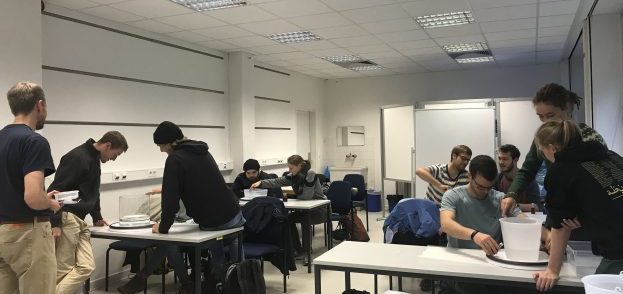The inspiration for Torge’s and my PerLe teaching innovation project was a 2018 article by the DIYnamics team in which “affordable rotating fluid demonstrations for geoscience education” are presented. We were first intrigued, then excited, and since I have always wanted to have a rotating table to play with at home, there was nothing to stop us! So even before we had gotten the funding for the project, we were already building a private rotating tank and gaining experiences with it.
The DIYnamics team provides excellent instructions for ordering, building and operating their rotating table, and the more closely one follows their instructions, the better — maybe not surprisingly, but of course we had to make that experience ourselves — the table works.
The rotating table consists of a Lazy Susan (basically a round tray, sitting on an axis so it can swivel) and a Lego motor that drives it. In the image below, you see the motor in between the blue water bottle and the Lazy Susan. Yes, that’s really all there is to drive the rotation of a tank full of water!

The setup really is affordable, and that has the added benefit that there is a really low threshold for students to start “playing” with it. Playing is taken to mean exploring, experimenting, finding answers to questions that intrigue them, but all in a joyful way. Other, more complex setups require supervision or might even be operated exclusively by an instructor.
With our four identical setups, not only can the rotating tanks be used by small student groups in parallel, giving each student the opportunity of hands-on experimentation rather than just observation of a demonstration. Having four tanks also practically guarantees that each tank will show a slightly different realization of the same experiment. This then is a great reason to ask students to observe and explain similarities and differences between the different tanks. Running four experiments simultaneously makes comparison of different realizations a lot easier since we don’t have to rely on documentation but rather direct observations can be compared. It also substantially cuts down prep- and spin-up time.
The setup is also really flexible as in it packs down small enough to be easily transported to wherever we want to use it. Since we only need very little water in the tanks, operating the setup in a normal lecture room rather than designated lab spaces is not a problem, either.
We are very excited about the opportunities the DIYnamics rotating table provides, and we will keep you posted on our progress!
Literature:
Hill, S. A., Lora, J. M., Khoo, N., Faulk, S. P., & Aurnou, J. M. (2018). Affordable rotating fluid demonstrations for geoscience education: The DIYnamics project. Bulletin of the American Meteorological Society, 99(12), 2529-2538. https://doi.org/10.1175/BAMS-D-17-0215.1
